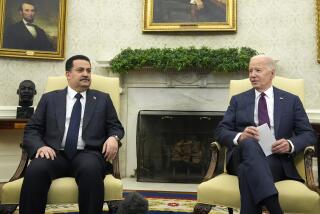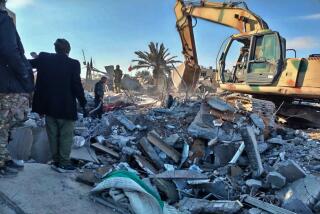U.S. Warplanes Patrol Iraqi Zone, Meet No Resistance : Persian Gulf: Baghdad vows to challenge ‘no-fly’ move, but retaliation may be political, not military.
- Share via
WASHINGTON — Waves of U.S. warplanes began patrolling the skies over southern Iraq on Thursday as Baghdad vowed to challenge the allied “no-fly” zone.
American F-18 and F-15 fighters and radar surveillance planes crisscrossed Iraqi territory below the 32nd Parallel beginning at dusk local time. They met no Iraqi aircraft and encountered no resistance from the ground.
“There have been no flights by Iraqi aircraft today below the 32-degree line. Only coalition aircraft are flying below the 32-degree line,” Pentagon spokesman Bob Hall said at a midday briefing Thursday. “There’s been no Iraqi reaction.”
U.S. fighter pilots returning to the aircraft carrier Independence after flying the initial missions over Iraq said the skies were quiet and antiaircraft batteries were silent.
“I don’t think the Iraqis will challenge us,” said Lt. Cam O’Kuinghuttons, an F-18 pilot from Nevada City, Calif. “In the past, they have shown themselves to be very belligerent in their rhetoric, supine in their action. I don’t think they want to challenge us, especially after last year.”
Although Baghdad’s aircraft appeared to be grounded, invective kept flying from the Iraqi capital.
Sword-wielding demonstrators in downtown Baghdad shouted “Down with Bush! Down with imperialism!” during a morning protest. Iraq’s governing council angrily promised to confront the U.S.-led flight ban, but Iraqi leaders indicated that their warplanes would not immediately engage the allies in combat.
“We shall choose the proper way and the proper time to confront this outrageous aggression,” declared a statement issued by President Saddam Hussein’s Revolutionary Command Council after the Iraqi leader presided over a joint session of the council and the ruling Arab Baath Socialist Party in Baghdad hours before the ban took effect.
The statement hinted strongly that Iraq will retaliate politically rather than militarily.
“We reserve the right to choose the way of action toward this aggressive resolution and the methods of rejecting it,” the Iraqi leadership stated, adding that Hussein and his council would decide on the matter “in due time.”
Among Iraq’s non-military options for retaliation against the air shield, according to several analysts in the Persian Gulf region, are a ban on future U.N. weapons inspections and U.N. relief operations on Iraqi territory--both of which have continued since the war’s end last year and are mandated under the U.N. cease-fire resolutions signed by Iraq.
Military analysts said that Baghdad’s preferred response to the no-fly zone would be to shoot down any allied planes over its territory but most agreed that Iraq’s air defenses, although partly rebuilt since the war, remain crippled by the two-month allied aerial assault on its key facilities that kicked off the fighting.
The Persian Gulf War allies, led by President Bush, decided to enforce the ban on all Iraqi flights below the nation’s 32nd Parallel after prolonged negotiations with leaders of Arab nations that had supported last year’s U.N.-sponsored military effort to drive Iraq’s occupation forces from Kuwait. Those Arab nations are critical logistics bases for the aerial patrols over southern Iraq.
Pentagon spokesman Hall said that the operation would be conducted by U.S., French and British aircraft based at airfields in Saudi Arabia and other Gulf nations, as well as by the air wing of the Independence. Additional AWACS radar surveillance planes and RC-135 electronic surveillance craft were flown into the region within the last 48 hours, he said.
In addition to monitoring Iraqi airspace, the allied flights will be able to track Iraqi troop movements in the south more closely than is possible with satellite surveillance. The Pentagon said it detected no increased Iraqi military activity in the area Thursday.
Among the more than 200 allied planes participating in the air patrols are F-14, F-15, F-16 and F-18 fighters, F-111, A-6 and F-117 Stealth fighter-bombers, A-10 Warthog ground-attack planes and a variety of specialized craft for radar suppression, electronic warfare, high-altitude surveillance and aerial refueling.
The British are contributing six Tornado fighters, and the French are sending 10 Mirage jets.
Officials said that the ban applies to Iraqi civilian as well as military aircraft, and Iraq has been warned that any plane that ventures into the area will be shot down.
In practice, civilian flights to the region have been suspended for several months because of shortages of spare parts.
Many of the pro-Western Sunni Muslim monarchs in the region fear that the no-fly zone, which was announced ostensibly to protect Iraq’s Shiite Muslims from Hussein’s air force, could lay the groundwork for carving out a separate Shiite state. Most Arab nations supported Hussein during his nation’s eight-year war against the fundamentalist, Shiite Muslim-majority regime in neighboring Iran.
Iraq’s leaders wasted little time Thursday in trying to use such fears as a wedge to break the allied resolve. The statement issued by the Iraqi ruling council said that all Arab leaders who support the new military effort “will be held fully responsible . . . before God, history, the Arab and Islamic nation and their own people.”
But White House National Security Adviser Brent Scowcroft, in a television appearance Thursday morning, said that the United States and its allies have no interest in the partition of Iraq.
“What we are trying to do is prevent genocidal acts on the part of Saddam Hussein in compliance with U.N. Resolution 688,” which forbids acts of repression against the Iraqi population, Scowcroft said. “It is not an attempt to break up Iraq.”
Broder reported from Washington and Fineman from Nicosia, Cyprus.
More to Read
Sign up for Essential California
The most important California stories and recommendations in your inbox every morning.
You may occasionally receive promotional content from the Los Angeles Times.













